Grand Teton Brewing Company - Lost Continent Double IPA
-
ABV:
8.0%
Grand Teton Brewing Company was founded in 1988 by Charlie and Ernie Otto as Otto Brothers’ Brewing Company, which was the first modern microbrewery in the state of Wyoming. In a quest for full-flavored, freshly-brewed, locally-produced beers, Charlie and Ernie, brothers of German-Austrian descent, built a small brewhouse in Wilson, Wyoming and secured the first malt beverage manufacturers’ permit issued in Wyoming in 35 years. Believing that great tasting, preservative-free, handcrafted beer could find a niche in the modern marketplace, the Otto brothers presented their flagship amber Teton Ale to local draught establishments in 1989.
The brothers wanted to bring Wyoming its first brewpub, but state law prohibited breweries to act as retailers. Charlie was undeterred, however, and in 1989 began three years of letter writing, phone calling and grass roots organizing to bring about the legalization of brewpubs in the Cowboy state. In 1992, Otto Brothers’ Brewing Company opened Wyoming’s first brewpub in Wilson.
In the spring of 1998 ground was broken for a new brewery at the base of Teton Pass in Victor, ID. The proximity to locally-grown barleys and Northwest hops, as well as nearby Teton Glacier water, made for an excellent location. The new facility boosted annual production and provided a fermentation system that allowed for both ale and lager production. The name change from Otto Brothers’ Brewing Company to Grand Teton Brewing Company took place in the fall of 2000.
Four or five times a year, the brewmaster’s special creative efforts are brought to market in the Cellar Reserve series of beers. These brews are unique, flavorful, strong, and are released only when they have aged to perfection. Production time is usually 3-6 months. The limited release higher-alcohol beers are “krausened” by blending newly fermenting beer into the finished beer to produce a secondary fermentation in the bottle. This bottle conditioning creates natural carbonation, a dense creamy head, and a fine layer of yeast on the bottom of each bottle. If properly handled, they can be laid down and should continue to mature in the bottle for months or even years.
The Imperial, or Double, IPA is a new American beer steeped in British tradition. At the end of the 18th century the British were firmly established in India and the colonists there needed beer. Brewing in India was impossible. It was too hot, water quality was poor, and barley and hops were unavailable. Several attempts were made to ship beer from England, with disastrous results. The sea voyage around the horn of Africa lasted months, with two crossings of the equator and usually rough seas. The sweet, dark ales of London, shipped in large wooden hogsheads, arrived flat, sour and undrinkable.
The British navy had tried to solve this problem for years, with little success. British sailors in the English Channel received a ration of a gallon of
strong brew a day, and became angry when they were forced to go without. The navy tried brewing onboard with concentrates, which worked in cooler climes,
but failed in warmer ones. The navy finally settled for grog, a less healthy mixture of rum, citrus juice and sugar.
The British in India would have been drinking grog, too, if not for a London brewer named George Hodgson, who made a pale ale that was stronger and more
bitter than his regular beers. The increased alcohol and hops helped to protect the beer from spoilage. He aged his ale in London for months, until the
yeast had consumed all the sugars in the beer, leaving little for spoilage organisms to eat. Finally, he added hops to each hogshead of finished beer for
additional protection.
The ale survived the journey in spectacular fashion—it arrived clear, strong, and aromatic. Few at home in England were familiar with the style until 1827, when a ship bound for Calcutta was wrecked in the Irish Sea. Some of the 300 hogsheads of IPA were salvaged and sold at auction in Liverpool, and soon people throughout England were demanding the new “India beer.” The style’s fame spread, and IPAs were brewed in Norway and even Germany. Several breweries on the East Coast of the United States brewed it as well. Ballantine’s IPA, brewed in Albany and then Newark, retained some of the style’s original character into the 1970s. By the 1980s, IPA was just another name for a low-strength bitter in Britain, and was all but forgotten in the U.S.
American craft brewers, particularly those on the West Coast, revived the style, and a few British producers have brought it back as well. Now a good, hoppy IPA is in the repertoire of most American craft brewers. British IPAs tend to be balanced, restrained, even subtle; American versions are bold and brash, usually featuring flavorful, aromatic Northwest hops such as Centennial and (most often) Cascade.
In recent years, American brewers have created a new style: “Imperial,” or “Double” IPA. The Grand Teton version is brewed with twice as much malt and hops as their everyday IPA, dry hopped with American Cascade and Amarillo hops, and fermented to 7.5 percent alcohol by volume. The hops provide citrusy, resinous spiciness, making this beer a great match for any bold, flavorful food.
Color: A satin sheen on pinkish, deep amber. Distinctive and quite beautiful. Pours with an equally aesthetic, meringue-like head.
Aroma: Floral. A country house with vases of wild flowers. Beeswax. Leather armchairs and polished oak furniture.
Palate: Thick-cut bitter orange marmalade on well-done toast. A hint of honey, toasted almonds on marzipan-filled croissants (to warm the entente cordiale).
Finish: Sufficiently bitter to arouse the appetite for lunch - even after such a voluptuous breakfast.
Comment: Huge, beautifully rounded and smooth, and worth the difficulty to unleash it. I really had to wrestle with mine, all that wire and wax….
Food pairing: Roast wild duck with orange sauce. Nothing less could stand up to this beer.


Unmatched Variety by style, brewery & country
Choose from Five different Beer Clubs offering unmatched variety by brewery,
country of origin, and beer style to suit your specific tastes.


